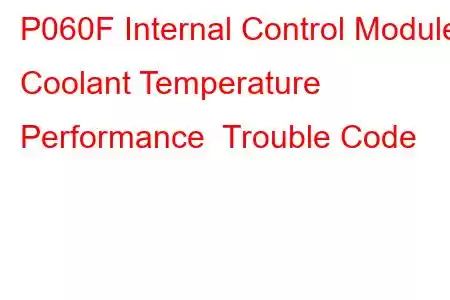P060F Internal Control Module Coolant Temperature Performance
OBD-II Trouble Code Technical Description
Internal Control Module Coolant Temperature Performance
What does that mean?
This generic powertrain diagnostic trouble code (DTC) typically applies to many OBD-II vehicles. That may include but is not limited to vehicles from Mazda, Ford, Honda, Chevrolet, Jeep, Dodge, etc.
When a code P060F is stored, it means that the powertrain control module (PCM) has detected an internal performance error with the engine coolant temperature (ECT) sensor circuit. Other controllers may also detect an internal PCM performance error (in the ECT sensor circuit) and contribute to a P060F being stored.
Internal control module monitoring processors are responsible for various controller self-test duties and overall internal control module accountability. ECT sensor input and output signals are subject to self-test and are monitored constantly by the PCM and other related controllers. The transmission control module (TCM), traction control module (TCSM), and other controllers are subject to interaction with the ECT sensor.
ECT sensors are composed of a thermal resistor that is dipped in a hard resin and sealed in a metal or plastic housing. Brass is the most common metal used as ECT sensor housing material. The ECT housing is designed so that it may be threaded into a coolant passage in the engine intake manifold, cylinder head, or block. As warm coolant passes through the passages and across the ECT sensor, the level of thermal resistance in the ECT sensor decreases. When engine coolant decreases in temperature, resistance increases and ECT sensor circuit voltage is reduced as a result. These fluctuations in resistance (which result in circuit voltage variations) are interpreted by the PCM as changes in engine coolant temperature. ECT sensor input data is critical in calculating fuel delivery and ignition timing strategy.
Whenever the ignition is on and the PCM is energized, internal ECT circuit self-tests are initiated. In addition to running internal controller self-tests, the controller area network (CAN) also compares signals from each individual module to ensure that all controller are functioning properly. These tests are performed simultaneously.
If the PCM detects a discrepancy between any of the on-board controllers, which would indicate an internal ECT sensor error, a code P060F will be stored and a malfunction indicator lamp (MIL) may be illuminated. Multiple failure cycles may be necessary for MIL illumination, depending upon the perceived severity of the malfunction.
Photo of a PCM with the cover removed:
What is the severity of this DTC?
Internal control module processor codes should be categorized as severe. A stored code P060F could result in serious drivability and fuel efficiency issues, suddenly and without warning.
What are some of the symptoms of the code?
Symptoms of a P060F trouble code may include:
Drivability issues (especially at start-up) Harsh or erratic automatic transmission shifting Reduction in fuel efficiency Rough idle or stall (especially at idle) Hesitation upon accelerationWhat are some of the common causes of the code?
Causes for this code may include: Defective controller or programming error Open or shorted circuit or connectors in the CAN harness Insufficient control module ground Defective ECT sensor Corroded electrical (ECT) connector Open or shorted circuits between the ECT sensor and the PCMWhat are some P060F troubleshooting steps?
Even to the most experienced and well-equipped professional technician, diagnosing a code P060F can prove to be quite a challenge. There is also the issue of reprogramming. Without the necessary reprogramming equipment, it will be impossible to replace a defective controller and complete a successful repair.
Read: 39


